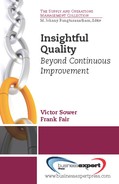0%
23Chapters
0-1Hours read
0kTotal Words
Book Description
Continuous improvement is essential but not sufficient to assure an organizations continued success. In order to be a market leader or indeed even to survive in many cases, resources must be devoted to longer-term strategic quality activities to address radical--possibly paradigm-shifting-- improvements that might affect the organization and its competitive position. These radical improvements might result from R&D efforts within the organization (proactive) that propel the organization and its products and services to the cutting edge of the markets in which they operate. Or these radical improvements might be developed by competitors or even by organizations in other industries (reactive) which, if ignored, might threaten the long-term survival of the organization if they are not recognized and reacted to in an appropriate way. This book is about how to think differently about quality and by doing so increase the creativity, innovation, and agility of an organization and its employees as well as the awareness of new developments in the marketplace and their possible impact on the organization and its markets. Quality must be addressed in strategic as well as operational terms in order for organizations to compete effectively over the long term. Strategic quality management requires insightful leadership. This book is about attaining the insight required to increase organizational creativity, innovation, and agility to create new paradigms, and survive paradigm shifts that originate outside the organization. Each chapter contains short cases illustrations about real organizations that illustrate the main points of that chapter. This book does not describe a detailed process that ostensibly leads to insight. Rather this book takes the position that what works for one organization might not work as effectively for another. It challenges leaders and managers to adopt a new way of thinking and presents thought-provoking ideas about how organizations can begin the process of charting their own paths to insight--and lasting success.Table of Contents
- Cover
- Halftitle
- Titlepage
- Copyright
- Testimonials
- Abstract
- Contents
- List of Tables
- List of Figures
- List of Examples
- Abbreviations and Acronyms
- Acknowledgments
- Chapter 1 Introduction
- Chapter 2 Why Continuous Incremental Improvement Is Not Sufficient for Organizational Success
- Chapter 3 Insight
- Chapter 4 The Insightful Organization
- Chapter 5 Insightful Ways of Thinking for Managers
- Chapter 6 Insightful Use of Existing Tools
- Notes
- References
- Index
- Last Page
- Backcover
